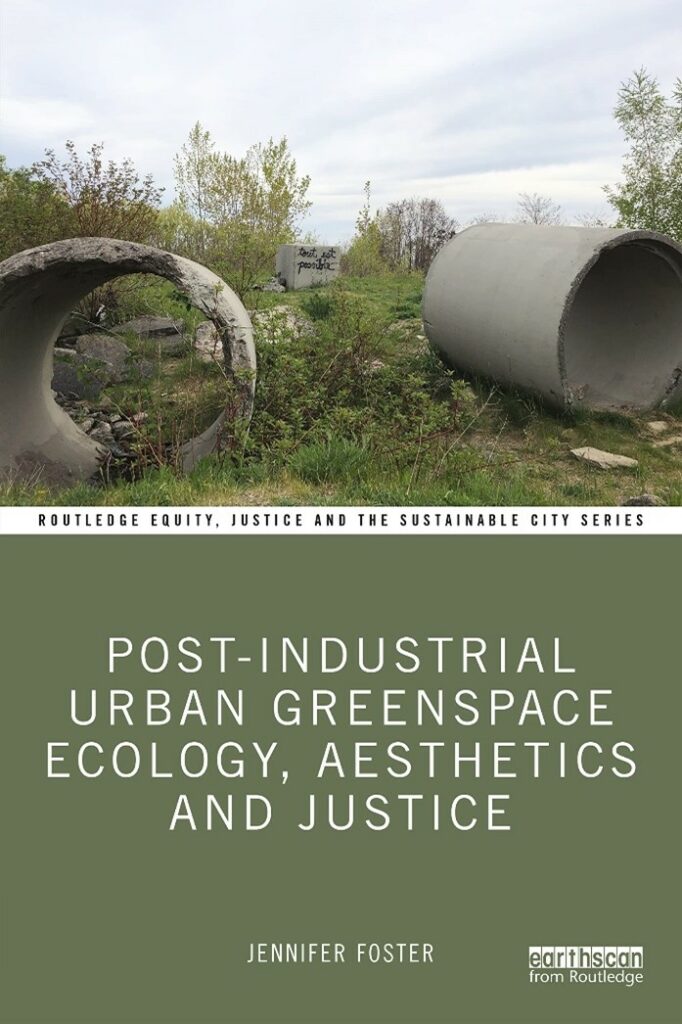
The Faculty of Environmental & Urban Change (EUC) will host a launch event for Associate Professor Jennifer Foster’s latest book, Post-Industrial Urban Greenspace: Ecology, Aesthetics and Justice (2022) on Friday, May 19 at 1 p.m. in HNES 142.

Inspired by “the power of nature to thrive – no matter the conditions – and the impressive ways that communities build restorative and reparative futures in these places,” Foster’s book examines the means through which urban environments become habitats. For the book’s launch, Foster will discuss her work with a guest panel featuring: Sean Kheraj, environmental historian, vice-provost at Toronto Metropolitan University and host of the Nature’s Past podcast; Loren March, PhD candidate at the University of Toronto; and David Miller, former mayor of Toronto and managing director of the C40 Centre for City Climate Policy and Economy.
To accommodate all potential viewers, this event will also broadcast via Zoom. To join the broadcast contact Denise McLeod.
In anticipation of the book launch, Foster met with graduate student researcher Danielle Legault to talk about urban habitat creation in old industrial sites, and their social and biological significance.
Q: Can you speak to how this book fits into the longer trajectory of your academic work?
A: My work explores urban habitat creation, including examining contemporary environmental orthodoxies, or received wisdoms about how nature works, in favour of more nuanced interpretations that incorporate concepts like novel ecologies, queer ecologies, anti-colonial ecologies and environmental justice.
Since the mid-2000s, my work has focused specifically on post-industrial urban greenspaces and their evolution in relation to environmental justice concerns. This involves a lot of field work, which I love. I get to explore some of the most fascinating urban spaces – for instance, old factories, dumps, rail lines – and talk to people who care deeply about these places.
This book is about old industrial sites that have been abandoned, or at least left to be without formal management. These sites are not conventionally beautiful, they are typically evaluated as unsafe and their ecologies are scorned as overgrown weeds. Yet, they offer some of the best opportunities for ecologically rich and socially inclusive greenspace. They are life-giving hotpots, nuclei of urban bounty. And they function as alternative public spaces that provide relief from surveillance and other stressors, as well as opportunities for pleasure that diverge from the mainstream.
Q: What drew you to Milwaukee, Paris and Toronto as sites of exploration in your book?

A: Each of these cities offers insight into possibilities for large-scale old industrial urban spaces, and together they demonstrate that nothing is predetermined. Milwaukee is my mother’s hometown, and it’s a place where people are very proud of their working-class manufacturing roots. It’s also an incredibly beautiful and ecologically rich city. After the industrial core of Milwaukee was devastated in the 1980s and ‘90s, and the large central valley became a putrid no-go zone, a local community health center led the charge in imagining a future for this valley that serves existing residents. Emphasizing the social determinants of health, the valley was cleaned up, made accessible and inviting, and re-industrialized with quality jobs for local residents.
I spent my youth on the edges of Paris, thanks to my father’s job. Paris is glamourous and picturesque, but up to the early 1990s the edges of the city were also heavily industrial. Friends and I loved trespassing to explore the rail line that connected the city’s factories, abattoirs and warehouses. When the trains stopped running along the tracks and the rail company let it all go wild, this 32-kilometer ring became one of the most stunning urban greenspaces. I had to return and get to know it once again.
Anyone who has spent time at Toronto’s Leslie Street Spit knows that it defies description. It is a former construction waste dump, it is a world-class birding site and it is an archive of the buildings and communities that have been destroyed. It is a place of refuge from the city, it is a landscape of astounding biodiversity and it is home for many people. I have been visiting the Spit since I came to Toronto in the mid-1990s and it is my favourite part of the city.
Q: What actionable steps for promoting equitable, sustainable development do you hope readers will discover?
A: Letting go of conventional conceptions of ecology is crucial, as is becoming curious about the incredible beauty and richness of so-called degraded urban lands. I am not a fan of hiding the scars of industrial development or sanitizing industrial legacies, and I hope that we can move away from the habit of “greening over” these spaces through park planning and design. Embracing novel ecosystems, including those comprised of ostensibly exotic or non-native species, allows us to support urban environments that are self-sustaining and richly biodiverse habitats. This means resisting conventional Western aesthetic conceptions of what is beautiful, appropriate and ecologically desirable. Whenever possible, the needs and preferences of marginalized communities must be prioritized, as well as those with historic connections to industrial labour and working-class experiences of these places.
Finally, I hope that we can become more comfortable with the ideas of vacancy and indeterminacy, that urban spaces don’t always have to fit into recognizable categories with functional identities in relation to neoliberal progress. I hope that we can leave these spaces to evolve in unexpected ways, with unplanned uses that respond to the needs of alternative lived experiences.
Q: Having completed this book, how do you see your work moving forward in the future?
A: I will continue exploring the core themes of this book, such as urban political ecology, environmental justice, novel ecologies and habitat creation. But my work going forward will focus even more on ecological repair and restorative urban landscapes. I am particularly interested in prison ecologies, based on the experiences of incarceration of many of my family members and friends. I am inspired by energy and leadership of Indigenous scholars, activists and communities, and plan to do a lot of close listening and thinking about how we invest in anti-colonial futures. Whatever happens, I know that I will be spending a lot of time in messy ecosystems.
